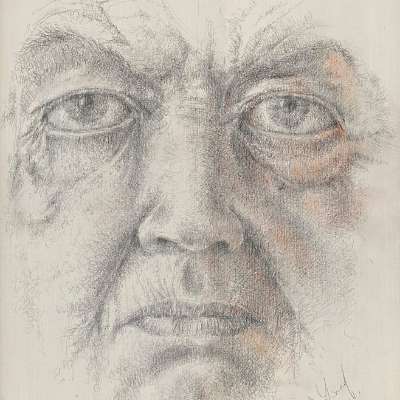Ukhnalev Evgeny
Evgeny Ukhnalev was born in Leningrad in September of 1931. He survived with his family during the first winter of the city blockade before being evacuated to the Urals. The Ukhnalevs returned to Leningrad shortly after the end of the blockade and Evgeny enrolled at the art school at the Academy of Arts. However, Evgeny left the art school to go to a shipbuilding technical school at his father’s request. At the age of seventeen, the artist was arrested with accusations of attempting to tunnel into Lenin’s mausoleum and he was incriminated in an attempt on Stalin’s life. Ukhnalev was condemned to death, but this sentence was later commuted to twenty-five years of hard labour in a prison camp. He spent one year in the Kresty prison in Leningrad, and thereafter was imprisoned in the Vorkuta camp. He was impelled to work as a copyist and later as an architect at one of the secret research and development laboratories known colloquially as sharashka. The artist always looked for a chance to draw scenes of the prison camp with its coal mines and barracks. He drew on tiny pieces of paper with pen and inkwell. He also drew portraits of his friends which he gave them as keepsakes. In 1954, after Stalin’s death, Evgeny Ukhnalev was released from prison and all charges against him were dropped after five years.
Evgeny Ukhnalev returned to Leningrad and worked as a technician and later as an architect at various design institutes. He didn’t need professional training because of the experience he had gained at the sharashka.
Ukhnalev worked as a head architect of the Hermitage for eight years starting in 1967. He restored facades and interiors and organized exhibitions. Apart from his Hermitage work, he also worked in his home illustrating books and publications. He has actively practiced painting and graphics since starting his work from home.
Even the early drawings of the prison period show the typical features of his technique and composition which now can be seen in his paintings and graphics. In his earliest works from the 70s, he worked on subjects where the present, past and future become interconnected. For instance, the classical architecture of Petersburg is overgrown with roots of unknown plants and covered with snow, and houses are deep in thought and lost in darkness.
In the 80s, Evgeny Ukhnalev took part in many exhibitions of unofficial art in Leningrad.
The artist doesn’t sketch from nature. Sometimes he uses photographs to create his pictures. It seems that the specificity within his works is caused by his outstanding memory that is able to remember each minute detail. Evgeny Ukhnalev remembers the first day of the War and the paper snowflakes hung on barrack walls which were left during that year because the northern summer was too short.
Ukhnalev designed the monument to the victims of Stalin’s terror in Saint-Petersburg. In 1977, Ukhnalev was bestowed the honorary title as a Distinguished Artist of Russia.

Selected Awards and Premiums:
-
Was awarded the medals: "50 Years of Victory in Great Patriotic War of 1941–1945" (1995);
-
"In Commemoration of the 300-th Anniversary of St. Petersburg" (2003);
-
"In honor of the 60th Anniversary of the Complete Liberation of Leningrad from the Nazi Blockade" (2004).
Selected Solo Exhibitions:
-
2011 Erarta Museum and Galleries of Contemporary Art, St. Petersburg, Russia.
-
2001 State Hermitage Museum, St. Petersburg, Russia.
-
1997 Anna Akhmatova Museum, St. Petersburg, Russia.
-
1995 Cultural Center of Salzburg, Austria.
-
1993 Solo exhibitions at galleries and exhibition halls, San Francisco, CA, USA.
-
1988 Dostoevsky Museum, Leningrad, USSR.
Selected Public and Private Collections:
-
State Hermitage Museum, St. Petersburg, Russia;
-
Anna Akhmatova Museum, St. Petersburg, Russi;
-
Erarta Museum and Galleries of Contemporary Art, St. Petersburg, Russia;
-
Kemerovo regional museum of fine arts, Kemerovo, Russia;
-
In private collections in Russia, Finland, Sweden, Germany, USA.





